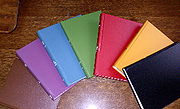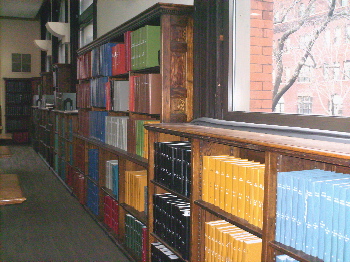
Library binding
Encyclopedia
Library binding is the term used to describe the method of binding serials
, and re-binding paperback
or hardcover books, for use within libraries. Library binding increases the durability of books, as well as making the materials easier to use. The stiffening
process is a low-cost, in-house alternative to library binding of paperbacks.
. However, library bound books also benefit library patrons by ensuring that the volume in hand is complete, opened with ease, and easy to photocopy
.
In addition, many libraries re-bind damaged books in library bindings regardless of whether they were originally paperback or hardcover.
called oversewing
to secure the volumes. Oversewing involves cutting or milling off the spines of the volumes, creating a block of loose pages. Then the loose sheets are combined into small units or signatures, which are secured with overlock stitching. The separate signatures then get sewn together, creating a single book block. Often a piece of linen is glued to the book block spine for further support. The spine of the volume sometimes is rounded and backed to keep the spine from caving in. But if the paper of the volume is too fragile, or the book block is too thick, the spine is left flat. The book block is placed in a sturdy cover or case, with special paper covering the inside covers (Boardway 1993).
 The most common cloth used by library binders to cover the boards of the book is buckram
The most common cloth used by library binders to cover the boards of the book is buckram
coated with acrylic. Acrylic coatings are generally resistant to water, mold, insects, and ultra-violet light. The buckram used is a 100% cotton, bulky fabric designed to withstand wear and tear (Jones 1993). Smaller books may be bound in c-cloth, a lighter weight cloth that may or may not have an acrylic coating. The information about the volume (such as title and call number) are hot-stamped onto the spine. Bound serials are typically all bound in the same color of buckram, in order to indicate the relationship of the volumes.

Serial (literature)
In literature, a serial is a publishing format by which a single large work, most often a work of narrative fiction, is presented in contiguous installments—also known as numbers, parts, or fascicles—either issued as separate publications or appearing in sequential issues of a single periodical...
, and re-binding paperback
Paperback
Paperback, softback or softcover describe and refer to a book by the nature of its binding. The covers of such books are usually made of paper or paperboard, and are usually held together with glue rather than stitches or staples...
or hardcover books, for use within libraries. Library binding increases the durability of books, as well as making the materials easier to use. The stiffening
Stiffening
In bookbinding, stiffening is a process whereby paperback books are reinforced for use in libraries, without change to their fundamental binding structure...
process is a low-cost, in-house alternative to library binding of paperbacks.
Purpose
Library binding is a way to increase the life of books and periodicals used in libraries. This is done by sewing the pages in place and by reinforcing the spine for each volume. The goal of library binding is long-term preservationPreservation (library and archival science)
Preservation is a branch of library and information science concerned with maintaining or restoring access to artifacts, documents and records through the study, diagnosis, treatment and prevention of decay and damage....
. However, library bound books also benefit library patrons by ensuring that the volume in hand is complete, opened with ease, and easy to photocopy
Photocopier
A photocopier is a machine that makes paper copies of documents and other visual images quickly and cheaply. Most current photocopiers use a technology called xerography, a dry process using heat...
.
In addition, many libraries re-bind damaged books in library bindings regardless of whether they were originally paperback or hardcover.
Methods and materials
Most library binders use a method of bookbindingBookbinding
Bookbinding is the process of physically assembling a book from a number of folded or unfolded sheets of paper or other material. It usually involves attaching covers to the resulting text-block.-Origins of the book:...
called oversewing
Oversewn binding
Oversewn bindings are a type of bookbinding produced by sewing together loose leaves of paper to form a text block. Threads pass through small holes that have been punched in the signature's gutter margin , forming overlock stitches that attach it to previously attached sections...
to secure the volumes. Oversewing involves cutting or milling off the spines of the volumes, creating a block of loose pages. Then the loose sheets are combined into small units or signatures, which are secured with overlock stitching. The separate signatures then get sewn together, creating a single book block. Often a piece of linen is glued to the book block spine for further support. The spine of the volume sometimes is rounded and backed to keep the spine from caving in. But if the paper of the volume is too fragile, or the book block is too thick, the spine is left flat. The book block is placed in a sturdy cover or case, with special paper covering the inside covers (Boardway 1993).

Buckram
Buckram is a stiff cloth, made of cotton, and still occasionally linen, which is used to cover and protect books. Buckram can also be used to stiffen clothes. Modern buckrams have been stiffened by soaking in a substance, usually now pyroxylin, to fill the gaps between the fibres.In the Middle...
coated with acrylic. Acrylic coatings are generally resistant to water, mold, insects, and ultra-violet light. The buckram used is a 100% cotton, bulky fabric designed to withstand wear and tear (Jones 1993). Smaller books may be bound in c-cloth, a lighter weight cloth that may or may not have an acrylic coating. The information about the volume (such as title and call number) are hot-stamped onto the spine. Bound serials are typically all bound in the same color of buckram, in order to indicate the relationship of the volumes.
Library binders
Library binding is done at a commercial library binding company. Sending books to the library binder is a mass production process. The library will gather and set aside their volumes which they want library bound, and then box and ship off these books to a library binding company. The binding company handles each volume one at a time, and then places all the items from the shipment back into boxes and sends them back to the library.
- Commercial library binding factories were first established in AmericaAmericasThe Americas, or America , are lands in the Western hemisphere, also known as the New World. In English, the plural form the Americas is often used to refer to the landmasses of North America and South America with their associated islands and regions, while the singular form America is primarily...
and EnglandEnglandEngland is a country that is part of the United Kingdom. It shares land borders with Scotland to the north and Wales to the west; the Irish Sea is to the north west, the Celtic Sea to the south west, with the North Sea to the east and the English Channel to the south separating it from continental...
in the early twentieth century. Since then, there have emerged several prominent library binding companies (including Dague Bookbindery, Ocker & Trapp, or Wert Bookbinders). Although they are commercial enterprises, library binders act as partners to the library world. The operations they perform on books and serials help extend the life of these materials, making them more accessible to library users. The goal should always be to do as little damage to the volume as possible. A volume should not be sent to a commercial library binder if the papers in the volume are brittle, if the volume appears to have value as an artifact, if the item can be repaired or treated in-house, or if the item needs preparatory conservation treatment. - Library binders and libraries must agree on the conditions of the services provided and the prices rendered, and then must sign a contract confirming these. The library binder should ensure against the loss of volumes and should correct any mistakes (such as the wrong color buckram cloth, or the incorrect title stamped on the spine) (State of Connecticut Binding Contract 1993).
- The Library Binding Institute http://www.lbibinders.org is the main source of information and standards on library binding. In conjunction with the National Information Standards Organization, the Library Binding Institute has published standards of library binding that should be used by all binding companies. These include technical specifications (for the different methods of library binding) and material specifications (for the materials used in library binding).
External links
- Guidelines for Library Binding (from the Northeast Document Conservation Center)

